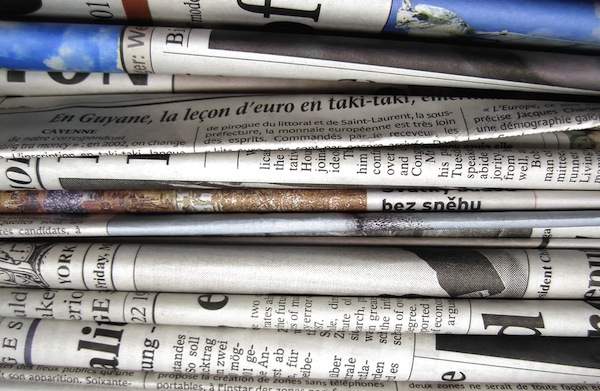Every week we round up industry news you may have missed while you were coming back with a vengeance.
- Remember back in those heady days of March 2012 when a Pew Report found newspapers were losing $7 in print revenue for every new dollar in digital revenue?
Wrong, says Alan Mutter. Since 2005, publishers have actually lost $27 for every dollar in digital revenue.
That was just the sound of our soul being crushed, Mr. Mutter. Pay it no mind. Please continue:
My analysis starts in 2005, the best year ever for newspaper ad sales, when combined print and digital revenues were $49.4 billion. Industry sales have fallen unrelentingly since then to $23.9 billion in 2011 … When you compare the industry’s sales performance from year to year since 2005, you see that print sales fall every time and that digital revenues advanced in four years but actually declined during the Great Recession in 2008 and 2009.
The net result is that $26.7 billion in print sales evaporated in the same six years that publishers netted $1.2 billion in new digital revenues.
Mutter also does birthdays, weddings, and graduation parties.
- So what’s the answer to newspapers’ business dilemma? “Rich dudes,” says David Carr:
Not the merely well off, but the kind of men with who long ago separated themselves from humdrum economic realities of life. Sure there are other expensive hobbies, but how many antique cars or 19th-century landscapes can you own? Newspapers may be short on profits, but they have become a new form of ostentation. How rich is he? He can afford to own a newspaper, for crying out loud.
But what about editorial independence, Mr. Carr?
That moralism is a luxury that mostly belongs to another era, when newspapers had functional monopolies and everyone was dying to get their hands on them. Now selling a newspaper is akin to peddling a used Humvee, a hulking beast that has lost relevance in a changed landscape.
Can you put this into historical context for us?
If you pull back a few thousand feet, you can see newspapers coming full circle. Before World War II, newspapers were mostly owned by political and business interests who used them to push an agenda. People like William Randolph Hearst and Robert McCormick wielded their newspapers as cudgels to get their way. It was only when newspapers began making all kinds of money in the postwar era that they were professionalized and infused with editorial standards.
- Online advertising hit $84.8 billion in 2011.
- Mr. Buttry, do you have any words for the newsroom curmudgeons among us?
You may be resisting digital journalism because you think journalism was so great back in the day and today’s journalism just doesn’t measure up. I share your pride in journalism’s glorious past … Digital journalists value investigative journalism and high standards as much as traditional journalists, even if the tools and standards may be different.
- Ms. Hesser, got any advice for the aspiring food writers among us?
I can no longer responsibly recommend that you drop everything to try to become a food writer. Except for a very small group of people (some of whom are clinging to jobs at magazines that pay more than the magazines’ business models can actually afford), it’s nearly impossible to make a living as a food writer, and I think it’s only going to get worse.
- Hey Hamilton, did you see the story about the reporter who was so excited to be hired by Gannett’s Wilmington News Journal that he wrote a fun press release for his family to see, which got picked up by Romenesko, and then the paper fired him for improper use of their logo? What’s the lesson here? Is this just Gannett being Gannett?
NEWSPAPER WORK MUST NEVER BE FUN … God forbid a newspaper editor’s “hiring-letter quotes” get out into the world at large. That could almost be construed as news. And god forbid anyone see a newspaper’s logo on the internet. That could, theoretically, lead someone to read this newspaper. That’s an immediate firing offense. And happiness, about being hired into the newspaper industry? Sign of mental instability. Fire him at once.
- And some final advice for aspiring journalists comes from the American Journalism Review: Learn to do it all. Being a jack-of-all-trades is the new normal. NBD.
- How the Texas Tribune is making $5K a month from Google microsurveys.
- Who are local news enthusiasts? Pew Research is on it.
- How 25 national magazine award nominations went to 25 male writers.
- Where did #longreads and longform come from? BuzzFeed is on it.
- More than twice as many mobile users prefer news orgs’ mobile websites over apps.
- Emerson College student paper completes a fully responsive, mobile-friendly redesign.
- Advertisers recycle print ads for tablets.
- Local online ad spending is red hot again.
- Consumers who read digital newspaper content respond to digital advertising as well, says NAA.
- The Oatmeal on how to get more likes on Facebook: Create things that are hilarious, sad, beautiful, interesting, inspiring, or simply awesome. And more cage-fighting nuns.
- And finally, Choire Sicha has found out who is destroying America’s newspapers: Copy editors. With their puns.

